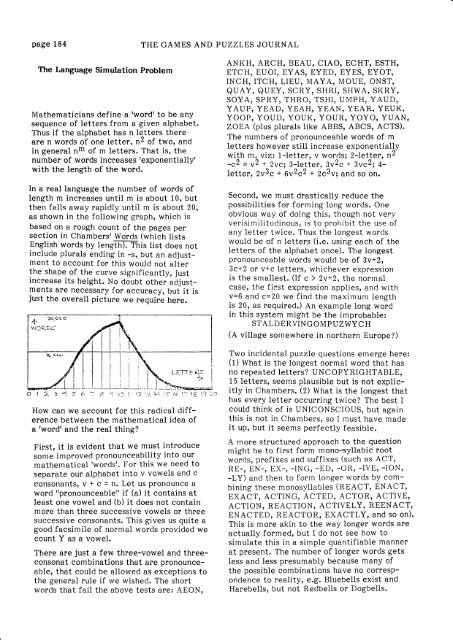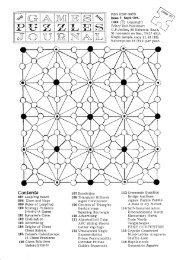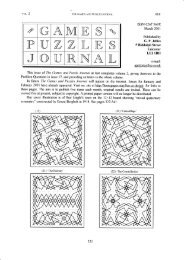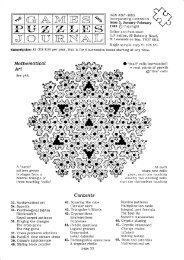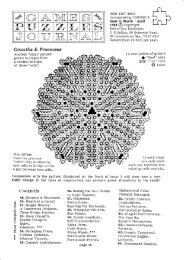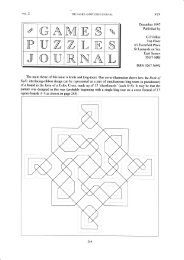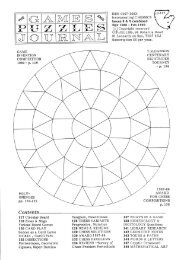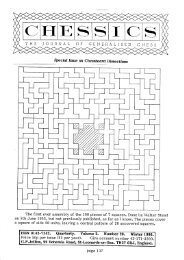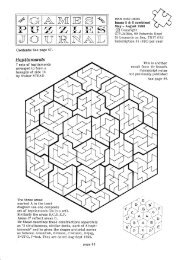The Games and Puzzles Journal, #12 - Mayhematics
The Games and Puzzles Journal, #12 - Mayhematics
The Games and Puzzles Journal, #12 - Mayhematics
You also want an ePaper? Increase the reach of your titles
YUMPU automatically turns print PDFs into web optimized ePapers that Google loves.
page 184<br />
THE GAMES AND<br />
PUZZLES JOURNAL<br />
<strong>The</strong> Language Simulation Problem<br />
Mathematicians define a twordr to be any<br />
sequence of letters from a given alphabet.<br />
Thus if the a).phabet has n letters there"<br />
are n words oi one letter , fiZ of two, <strong>and</strong><br />
in general nm of m letters. That is, the<br />
number of words increases 'exponentiallyl<br />
with the length of the word.<br />
In a real language the number of words of<br />
length m increases until m is about 10, but<br />
then falls away rapidly until m is about 20,<br />
as shown in the following graph, which is<br />
based on a rough count of the pages per<br />
section in chambers' words (which lists<br />
English words by lengTn)Lhis list does not<br />
include plurals ending in -s, but an adjustment<br />
to account for this would not alter<br />
the shape of the curve significantlv, just<br />
increase its height. No doubt other adjustments<br />
are necessary for accur&cy, but it is<br />
just the overall picture we,require here.<br />
?a'oc o<br />
,'lr<br />
WCRrr:-<br />
How can we account for this radical difference<br />
between the mathematical idea of<br />
a 'wordt <strong>and</strong> the real thing?<br />
First, it is eviclent that we must introduce<br />
some improved pronounceability into our<br />
mathematicat twords'. For this we need to<br />
separate our alphabet into v vowels <strong>and</strong> c<br />
consonants, v + c = 11. Let us pronounce a<br />
word rrpronounceable" if (a) it contains at<br />
least one vowel <strong>and</strong> (b) it does not contain<br />
more than three successive vowels or three<br />
successive consonants. This gives us quite a<br />
good facsimile of normal words provided we<br />
countYasavowel.<br />
<strong>The</strong>re are just a few three-vowel <strong>and</strong> threeconsonat<br />
combinations that are pronounceable,<br />
that eould be allowed as exceptions to<br />
the general rule if we wished. <strong>The</strong> short<br />
words that fail the above tests are: AEON,<br />
ANKH, ARCH, BEAU, CIAO, ECHT, ESTH,<br />
ETCH, EUOI, EYAS, EYED, EYES, EYOT,<br />
INCH, ITCH, LIEU, MAYA, MOUE, ONST,<br />
QUAY, QUEY, SCRY, SHRI, SHWA, SKRY,<br />
SOYA, SPRY, THRO, TSHI, UMPH, YAUD,<br />
YAUP, YEAD, YEAH, YEAN, YEAR, YEUK,<br />
YOOP, YOUD, YOUK, YOUR, YOYO, YUAN,<br />
ZOEA (plus plurals like ABBS, ABCS, ACTS)"<br />
<strong>The</strong> numbers of pronounceable words of m<br />
letters however still increase exponentially<br />
with m,- viz: l-Ietter, v words; Z-let-ter, nZ-<br />
-cz = vZ + Zvc; 3-tetter, 3v2s * 3ve2; 4'-<br />
tetter, 2v3c + 6vZcT + icSr; <strong>and</strong> so on.<br />
Second, we must drastically reduce the<br />
possibilities for forming long words. One<br />
obvious way of doing this, though not ver:/<br />
verisimilitudinous, is to prohibit the use of<br />
any letter twice. Thus the longest words<br />
would be of n letters (i.e. using each of the<br />
letters of the alphabet once). <strong>The</strong> longest<br />
pronounceable words would be of 3v+2,<br />
3c+2 or v*c letters, whichever expression<br />
is the smallest. (tf c<br />
case, the first expression appties, <strong>and</strong> with<br />
v=6 <strong>and</strong> c=20 we find the maximum length<br />
is 20, as required.) An example long word<br />
in this system might be the improbable:<br />
STALDERVINGOMPUZWYCH<br />
(e vilage somewhere in northern Europe?)<br />
Two incidental puzzle questions emerge here:<br />
(1) What is the longest normal word that has<br />
no repeated letters? UNCOPYRIGHTABLE,<br />
15 letters, s€ems plausible but is not explicitly<br />
in Chambers. (2) What is the longest that<br />
has every letter occurring twice? <strong>The</strong> best I<br />
could think of is UNICONSCIOUS, but again<br />
this is not in Chambersr so I must have made<br />
it up, but it seems perfectly feasible.<br />
A more structured approach to the question<br />
might be to first form mono-syllabic root<br />
worcls, prefixes <strong>and</strong> suffixes (such as ACT'<br />
RE-, EN-, EX-, -lNG, -ED, -OR, -lVE, -loN,<br />
-LY) <strong>and</strong> then to form longer words by combining<br />
these monosvllables (nEACT, ENACT'<br />
EXACT, ACTING, ACTED, ACTOR, ACTIVE,<br />
ACTION, REACTION, ACTIVELY, REENACT,<br />
ENACTED, REACTOR, EXACTLY, <strong>and</strong> so on).<br />
This is more akin to the way longer words are<br />
actually formed, but I do not see how to<br />
simulate this in a simple quantifiable manner<br />
at present. <strong>The</strong> number of longer words gets<br />
less <strong>and</strong> less presumably because many of<br />
the possible combinations have no correspondence<br />
to reality, e.g:. Bluebells exist <strong>and</strong><br />
Harebells, but not Redbells or Dogbells.


